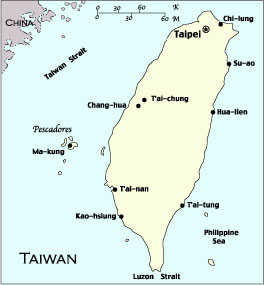 |
A Brief
History of Taiwan |
The Neolithic Age
began on Taiwan about 7,000 years ago. Archeologists
have found Neolithic artifacts throughout the island
that share similarities with clay objects discovered along the southeastern coast of China. Items form the
early Tafenkeng Culture can be found throughout Taiwan's
eastern coast. Larger stone implements are from the
later Chilin Culture and Peinan Culture. Archeologists
believe the ancestors of Taiwan's indigenous peoples
made these relics.
along the southeastern coast of China. Items form the
early Tafenkeng Culture can be found throughout Taiwan's
eastern coast. Larger stone implements are from the
later Chilin Culture and Peinan Culture. Archeologists
believe the ancestors of Taiwan's indigenous peoples
made these relics.
Before the mass migration of people to
Taiwan in the 17th century from Fukien and Canton Provinces along the southeast
Chinese coast, Taiwan was solely the domain of aboriginal peoples. While
considered part of the Autornesian-language ethnic group by ethnographers,
Taiwan's indigenous peoples had distinct languages, material cultures, and
social structures. In the 19th century, ethnographers believed that aborigines
came to Taiwan at different times and settled in various places after journeys
from the south (such as modern-day Philippines and Indonesia), aided by sea
currents and seasonal winds. However, the theory that tribes in neighboring
regions to Taiwan's southern flank originated from Taiwan has gradually gained
the upper hand in the last decade.
In the middle of the 16th century, Western
European sea powers arrived in the seas off East Asia. Once the Spanish occupied
Manila, the East China Sea and South China Sea became lively regions for
adventuresome traders and pirates. Given this sort of background, the island of
Taiwan became an object of competition for Europeans, Chinese, and Japanese. In
1624, the Dutch East India Company established a foothold in the Tainan area as
a center to trade with China. Contract laborers came to Taiwan from Fukien
Province on the mainland to produce tropical crops such as sugar cane and rice.
As the Dutch East India Company continued to sell special permits for the sale
of various commodities and proselytized the aboriginal peoples, this could be
termed the first appearance of a quasi-governmental presence on Taiwan.
In 1662, Cheng Chen-kung, who was defeated
while resisting the new Ching dynasty in China fro coastal Fukien, retreated to
Taiwan and forced the Dutch out. Cheng's forces consisted of pirates and trader
adventurists who circulated around Asia in the latter half of of the 17th
century; yet once they arrived in Taiwan, they established the island's first
Chinese-style regime. During the period of dynastic transition on the Chinese
mainland, a steady stream of Chinese living along its southeast coast sought
refuge on Taiwan.
Next Page
|
 |

 along the southeastern coast of China. Items form the
early Tafenkeng Culture can be found throughout Taiwan's
eastern coast. Larger stone implements are from the
later Chilin Culture and Peinan Culture. Archeologists
believe the ancestors of Taiwan's indigenous peoples
made these relics.
along the southeastern coast of China. Items form the
early Tafenkeng Culture can be found throughout Taiwan's
eastern coast. Larger stone implements are from the
later Chilin Culture and Peinan Culture. Archeologists
believe the ancestors of Taiwan's indigenous peoples
made these relics.